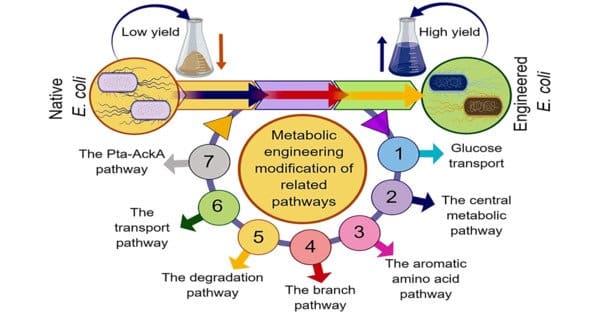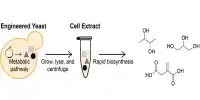The method of optimizing genetic and regulatory systems within cells to increase the cell’s synthesis of a specific substance is known as metabolic engineering. It is a branch of biotechnology concerned with developing and optimizing metabolic pathways inside microorganisms such as bacteria, yeast, and algae in order to create specific substances of interest. Biofuels, medicines, chemicals, and other important goods are examples of these molecules. These are chemical networks that use a succession of biochemical reactions and enzymes to turn basic resources into molecules required for cell viability.
The purpose of metabolic engineering is to manipulate these creatures’ cellular metabolism in order to increase the production of desired molecules while reducing the generation of byproducts. It aims to mathematically describe these networks, calculate a yield of useful goods, and identify network components that limit the creation of these products. The network can then be modified using genetic engineering approaches to alleviate these constraints. This changed network can be modeled again to calculate the new product yield.
Here are the key components and steps involved in metabolic engineering:
- Identifying Target Compounds: The first step is to determine the compound or compounds you want to create. This could be ethanol as a biofuel, insulin as a medicine, or a specialty chemical.
- Understanding Metabolic Pathways: Researchers must have a thorough understanding of the metabolic pathways involved in the target compound’s creation. This entails understanding the enzymes, substrates, and intermediates at work.
- Genetic Modification: The genome of the host organism is modified using genetic engineering techniques. To improve the production route, genes may be added, deleted, or altered. Genes responsible for competing metabolic pathways, for example, may be eliminated, while genes coding for enzymes implicated in the production pathway may be overexpressed.
- Balancing Metabolic Flux: Metabolic flux refers to the flow of metabolites through various pathways within the cell. To maximize the production of the target compound, metabolic engineers need to balance the flux to ensure that sufficient precursor molecules are available for the desired pathway.
- Strain Improvement: This involves selecting and evolving strains of microorganisms with improved characteristics for the desired production. This can be done through directed evolution or rational design approaches.
- Optimization: Metabolic engineers are constantly optimizing designed strains and growth conditions to improve target compound yield and productivity. Temperature, pH, oxygen levels, and nutrient availability may all need to be adjusted.
- Scale-Up: After developing a good strain in the lab, it must be scaled up to industrial production levels. This frequently entails fermenting enormous quantities of microorganisms in bioreactors.
The ultimate goal of metabolic engineering is to be able to employ these organisms on an industrial scale to create useful compounds in a cost-effective manner. Beer, wine, cheese, pharmaceuticals, and other biotechnology goods are current examples.
Some of the common strategies used for metabolic engineering are –
- overexpressing the gene encoding the rate-limiting enzyme of the biosynthetic pathway,
- blocking the competing metabolic pathways,
- heterologous gene expression, and
- enzyme engineering.














